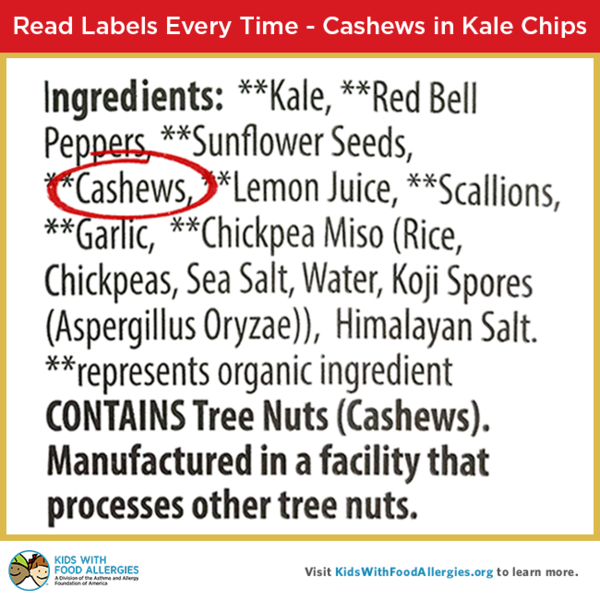Kale is growing in popularity as a nutritious vegetable that can be used in recipes, restaurant menus and in snack foods.This trendy vegetable is a member of the cabbage family.
But, don’t forget to read labels for items made with kale, such as dried kale snacks.
We were alerted by an allergist who contacted the Asthma and Allergy Foundation of America (AAFA) about two patients who suffered allergic reactions to kale chips. Why? The kale chips contained cashews. One of the patients told the doctor, “I didn’t think to read the label on kale chips.”
On one popular brand of kale chips, the front of the package is labeled gluten-free, vegan, non-GMO, organic, plain, and Kosher. When you turn it over, cashew, a type of tree nut, is listed in the ingredient statement.
Kids With Food Allergies (a division of AAFA) reminds parents, caregivers, teachers, camping staff, restaurant workers – anyone in charge of cooking for people with food allergies – to read every label, every time.
Even small amounts of food can cause a reaction called anaphylaxis, a serious allergic reaction.
Find more information on how to read labels for food allergy, in KFA's section on Choosing Safe Foods. We offer printable cards for hidden names of allergens and tips on label reading and how to find safe products.
Key points to remember:
- Foods regulated by the FDA will list top 8 food allergens in plain English somewhere in the list of ingredients label or in a “Contains” statement below the list of ingredients. (Top 8 = milk, egg, soy, wheat, peanut, tree nut, fish, crustacean shellfish.)
- Manufacturers are not required to bold the allergen on the packaging. You must read the entire ingredient label to look for allergens.
- Advisory labeling such as “may contain” is voluntary. Manufacturers are not required by the current labeling laws to disclose this information.
Where have you found unexpected allergens? Leave a comment here! (You must be logged in to leave a comment).



Comments (0)